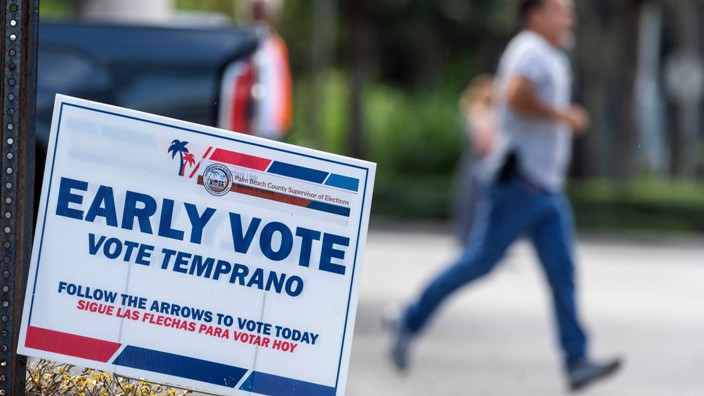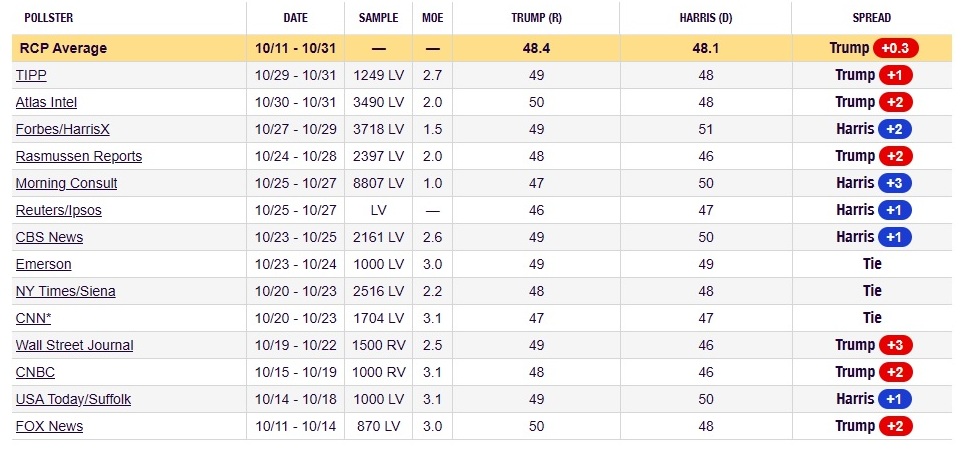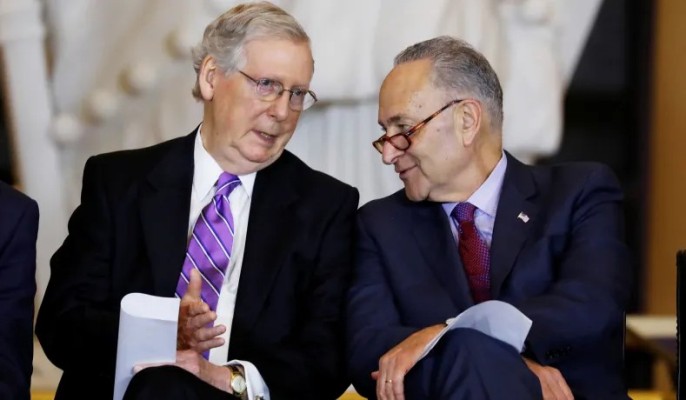 Photo credit: CNN
Photo credit: CNN
With just a few more hours until the 2024 election campaign season mercifully concludes, we are on track for one of the closest elections in U.S. presidential history if the polls can be believed. But some folks are not so sure about that, and are thinking in terms of "waves" and "landslides" that will deliver not just the White House but also the U.S. House and Senate. For example (just from the past few days):
But also:
These polar-opposite worldviews are hardly unexpected; the fragile snowflakes on both sides (there are far more on the left, but no shortage on the right either) need to be constantly reassured that things are going their way, no matter what "lies" they may hear which say otherwise. Pay no attention to the man behind the curtain and believe everything we tell you, they say. Well, somebody is lying, and somebody is going to be crushingly disappointed on November 6th or whenever the vote-counting finally ceases.
 Photo credit: Palm Beach Post
Photo credit: Palm Beach Post
Early Voting
We've heard a great deal about how well the GOP is allegedly doing in Early Voting, even in heavily Democrat states like New Jersey, and it's being claimed that Early Voting is going to be the critical determinant as to which side wins once all the votes are in.
The only available facts about Early Voting pertain to the number of ballots requested and returned, which are normally broken down by party registration in those states which actually register voters by party. Until election day when the ballots are counted, there is no way to know who the early voters actually voted for in any race. Therefore it is nothing more than assumptions at this point regarding any of the following:
Assumption #1: "Republicans vote for Trump, Democrats vote for Harris, and we have no clue about independents but we'll pretend that we do." A related happy assumption is that there will be less defections among Republicans than Democrats; i.e. more Democrats are crossing party lines to vote for Trump/Vance, than Republicans who are voting for Cackles and Tampon Timmy. This could turn out to be an unfortunately specious assumption, though not a particularly impactful one.
Assumption #2: Independents are "breaking for the challenger (Trump, in this case) as they normally do". That's probably just an old wives' tale to begin with, and yet another possibly incorrect assumption. All states have a significant number of so-called independent voters, and in numerous states there are more such voters than either Republicans or Democrats. Most people are likely unaware of this fact. So even if Trump, for example, holds 94% of Republicans but Harris only takes 92% of Democrats, that minor difference is absolutely swamped by how the indies vote.
A good illustration of the above comes from 2016 exit polling. Hillary did infinitesimally better (89%) among Democrats than Trump did among Republicans (88%). Both candidates lost 8% of their party to the other side and the remaining 3-4% voted for neither Trump nor Hillary. For every White lower/middle-class Democrat blue collar worker who was attracted by Trump's populist messaging, one liberal suburban soccer-mommy "lifelong" Republican ran sobbing hysterically over to the left and so it was a wash.
Indies made the difference in 2016. Trump did better with them than Hillary, 46% to 42%, though it wasn't sufficient to win the overall popular vote. But it was sufficient to help put him over the top in the closest states. That was 2016; Trump lost indies by 13 points in 2020 (54%-41%), while both he and Biden retained 94% of their own party's votes. Polls in 2024 are all over the place as they flail around trying to figure out how this critical segment of the electorate is going to vote; their sub-sample sizes are normally much too small to draw any conclusions from.
Assumption #3A: Increased GOP turnout in Early Voting will not "cannibalize" their turnout on election day. They'll still have enough voters who are willing to "crawl over broken glass" to get to the polls, and therefore the extra turnout we're seeing prior to November 5th is mostly a bonus!
Assumption #3B: On the other hand, relatively decreased Democrat turnout in Early Voting will persist through election day because many Democrats are too lazy to get up off their fat asses and stand in line; if they don't vote early, they likely won't vote at all!
The amount of bullshit those twin assumptions contain for 2024 remains to be seen. Perhaps, by coincidence, all of these assumptions will finally be correct and those who pretended they "knew" it all along will get to say "we told you so!". That would be great.
In the past, when Democrats thoroughly dominated Early Voting, we were assured that the Republican surge on election day would counterbalance the early Democrat advantage, and then some. But it never came close to doing so, even though Republican voters were often instructed to wait -- and specifically avoid voting early -- because of the fear of turnout cannibalization on the big day, and something about Democrats knowing exactly how much fraud they would need to commit.
Put it all together and you can see that there's a substantial disconnect from:
"GOP is doing a little better in early voting (we up, they down!)"
to:
"WE GONNA WIN RED WAYVE BAY-BEE!!!"
The main value these early voting stats have is propaganda value. In prior years the media and other Democrats could crow about what a huge advantage their party had and how it portended eventual victory; this year Republicans are crowing about how they have narrowed the gap a little bit or, in some cases, more than a little bit. What does it matter? Basically, it doesn't. A vote is a vote, no matter when it is cast. Even, when Democrats get their way, ones which come in well after election day.
In a nation as closely divided as this one, it appears that the potential for a "wave" that would sweep over the presidency, the Senate and the House is minimal. But it's not impossible. We'll say this much: if there is any kind of wave, it's probably going to be the kind we don't want to see. Republicans routinely underestimate the amount of hatred Democrats are capable of, and hatred is an excellent motivation for voting.
 Photo credit: Twitchy.com
Photo credit: Twitchy.com
The 2024 Presidential Election:
As most observers have known all along, it's going to come down to the seven swing states: Arizona, Georgia, Michigan, Nevada, North Carolina, Pennsylvania and Wisconsin. It's entirely possible that all seven will be decided by less than 5 points, possibly much less, and right now nobody knows for a fact exactly which way they are going to go. Maybe that's why they're called "swing" states.
Crackheads on the left are dizzily contemplating Harris winning. . . Texas! And Florida! And Ohio! And IOWA!
Their hopium-snorting counterparts on the right figure Trump has a damn good shot in. . . New Jersey! And Minnesota! And New Mexico! And VIRGINIA!
For another few hours they can still dream before the Methadone of reality kicks in. It will be just peachy if Trump can merely replicate what he did in 2016, by squeaking out razor-thin victories in enough of the swing states to get to 270. The Real Clear Politics recent polling averages show the following:
[As of 7:00 AM ET on 11/5]
- Trump up 2.8% in Arizona (11 EV)
- Trump up 1.3% in Georgia (16 EV) -- but Democrats are already working on the steal.
- Trump DOWN 0.5% in Michigan (15 EV)
- Trump up 0.6% in Nevada (6 EV)
- Trump up 1.2% in North Carolina (16 EV)
- Trump up 0.4% in Pennsylvania (19 EV)
- Trump DOWN 0.4% in Wisconsin (10 EV)
If this series of miniscule margins that generally favor Donald Trump -- ALL of which are within the margin of sampling error -- carry over to the actual vote counts, then Trump will prevail in the Electoral College by the count of 287 to 251 assuming all other states go as expected. Which means that the "Keystone" to the election is the state of Pennsylvania -- as we noted long ago and wrote about in considerable detail; it is tremendously likely that whoever wins PA wins the election.
There are a couple of things to keep in mind about all of these pollsters who are showing exceedingly close races in several states at the presidential level, and in other races as well:
- Blowout fantasies notwithstanding, the pollsters aren't wrong about how close things are.
Or are they?
Nate Silver thinks they're not only wrong, they are outright lying. He doesn't say for whose benefit they are lying (it's for their own benefit, actually, so as to keep themselves relevant). So who does he think is clearly ahead?
He says: Trump 55%, Cackles 45%. That's not an expected popular vote percentage (obviously), it's the probability of victory as Silver sees it. However just a few days earlier (October 23), Nate claimed "the election remains a 50-50 coin flip". Now he's angry at pollsters who say the same thing. Have things changed so dramatically since then? Has Trump really surged that much in two weeks?
 Real Clear Politics polling average as of 11/2: Trump vs. Harris (click image to enlarge)
Real Clear Politics polling average as of 11/2: Trump vs. Harris (click image to enlarge)
Trump has apparently improved his position, and it's not like a 55% chance of victory makes his election a mortal lock anyway. Presidential contests in the swing states really are likely to be nailbiters, regardless of whether Nate Silver objects or not. If the actual margins aren't quite as small as the pollsters are claiming and, for example, Harris wins and obtains a significantly greater number of votes than was expected, the pollsters will shed some crocodile tears regarding their lack of credibility. While at the same time gleefully accepting the outcome.
Even better for them: when 2028 rolls around these pollsters can be accused of having overstated Republican percentages in the recent past, instead of simply being shills for the Democrats. That would undoubtedly be a first in U.S. polling history, at least since the days of "Dewey Beats Truman!". It would remove a vital "crutch" ("ALL POLLZ ARE BI-USSSED TO THE LEFT!!1!) from amateur polling experts on the right. Let's pray it doesn't happen that way.
- By declaring so many tossups, the pollsters can't really be blamed if the result is slightly the opposite of what they predicted. Exactly how many decimal places are polls supposed to be accurate to?
For example, the final Pennsylvania poll from left-leaning (to put it mildly) Quinnipiac College asserts that Donald Trump will win by 1% there (47% to 46%) with a margin of error of 2.1%. If/when it turns out that Heels-Up Harris wins PA by a small amount then Quinnipiac can hardly be roasted for inaccurate forecasting; a swing of, say, 2% between their poll and the final outcome is not remarkable and only the perpetually-outraged would say otherwise. Besides, if the phrase "President Harris" ever becomes "a thing", there will be a hell of a lot more to be outraged about than some minor polling variance.
 Photo credit: National Review
Photo credit: National Review
The Senate:
The Democrats currently hold a 51-49 advantage, including the four so-called "independents" who march along with the Rats. If there is one certainty in the Senate this year, it is the Republicans picking up the West Virginia seat from the retiring Joe Manchin. Recent polling is somewhat sparse, but GOP challenger Tim Sheehy is supposed to be up by about 6 points against ultra-liberal Democrat incumbent Jon Tester in Montana and, along with everyone else who is already counting that chicken as having hatched, we'll agree that in 2024 Tester finally goes down in flames after a Senate career that was much longer than it should have been.
With those two seats in hand, it would be Republicans with the 51-49 advantage next year.
Next on the potential flip list is Ohio, a supposedly crimson "red" state (like Montana) which (also like Montana) has been electing a far-left Democrat to the Senate for far too long. This race is a tossup. Incumbent Sherrod Brown has won three times in the past, by 12 points in 2006, 6 points in 2012, and 7 points in 2018 (crimson red, my ass). But that was then and this is now. Brown is in a dogfight for the first time, with polls favoring him over Bernie Moreno by perhaps a single point. Brown's margin is slender, but he is ahead in almost 100% of the polls even including Trafalgar (R).
The potential bad news comes from Florida, Texas and even rock-solid crimson, burgundy, maroon Nebraska, where an "independent" phony-moderate candidate is supposedly within striking distance of squishy Republican incumbent Deb Fischer according to the far-left New York Times and the liberal candidate's own polls; all other polls forecast a normal Nebraska outcome. The Democrats did not even field a candidate here -- aside from the one who is calling himself an independent.
Republicans are likely to hold all three of those seats. The Rats are flooding Florida and Texas with $$$ but it would still be quite an upset if Ted Cruz or Rick Scott were to lose; some now classify the TX race as a tossup. The saving grace for these two Republicans could be the laughably poor quality of their liberal Democrat opponents. But the usual Democrat formula of (money + lies + hate) = victory certainly could work.
There's one important ingredient we left out of that equation, which helps Democrats greatly when money + lies + hate isn't quite sufficient. That ingredient is normally not added until after the votes are cast.
 Photo credit: The Hill
Photo credit: The Hill
It's not necessarily about voters actually supporting the dim-bulb Democrats in FL & TX; it's more about voting against the Republicans. Neither Scott nor Cruz are popular with anything more than the tiniest majority of the electorate in their states. Trump is going to win Florida and Texas and even though casual observers will be surprised to hear that a coattail effect might be required for Scott and Cruz, that very well may be the case. We'll say they both pull it out in the end.
Nebraska could be different (though it probably won't be), and that would be the biggest upset of them all. Trump will win Nebraska by an even larger percentage than Texas and Florida, but Fischer is claimed to be running so far behind Trump that she might lose her grip on his coat; she should hardly need such assistance in the first place. Trump is not universally popular in the Cornhusker state -- he is going to lose CD-2 (Omaha) again, and the electoral vote which goes with it; and the liberal GOP House incumbent in CD-2 (Don Bacon) is looking likely to be defeated by the slimy Democrat insect who's opposing him. Trump's support in Nebraska is enormous in the rural western two-thirds of the state, but is tenuous in the Lincoln area and underwater in Omaha.
And now for the potential good news:
In the House, Republican control is in serious jeopardy because of the number of toss-up districts they must defend, because of where the toss-up districts are located, and because of the dynamics of those districts including their partisan composition and the astronomical amount of "possibly" illegally-laundered "ActBlue" money Democrats are spending.
No, that's not the good news.
The good news is that in the Senate the situation is the opposite of the House in one important aspect: it is the Democrats who must do the defending in the marginal states. Those states are:
There are also lunatic fringe pipe dreams regarding Republican pickups in Maryland and Virginia. However the GOP has zero chance in Maryland and at most a 10% chance in the Virginia Senate race. But those other six states are going to be close, to one degree or another. Ohio and Wisconsin are the most likely pickups; Arizona (one outlier poll aside) and Nevada are the least likely. Pennsylvania and Michigan currently look improbable too.
In any event, this is all gravy for the Republicans. They have nothing to lose in these states and everything to gain.
The probability, however, is that they will gain nothing, or at most one. But it would take only a very slight shift to the right, and suddenly it could be another +2! Or more! All Senate polls are close in these marginal states and, on average, they all show the Republican losing.
Final score: The most likely outcome is a net gain of 2 or perhaps 3 seats for the GOP, which means the breakdown will be 51-49 or 52-48 in the Republicans' favor starting in 2025. It may be assumed that any "wave", however low the probability is that one occurs, can only push things further in the Republican direction. But don't completely discount the possibility of an unpleasant surprise in Texas or Florida. Worst case scenario: the Senate stays 51-49 Democrat, and that is not terribly likely.
 Photo credit: Fox News
Photo credit: Fox News
As far as the likely outcome: as we have noted on numerous occasions, having only 51 or 52 seats is not satisfactory to give the GOP anything but nominal control. There are at least two Republican senators -- Lisa Murkowski (Alaska) and Susan Collins (Maine) -- who are for all intents and purposes Democrats. They can continue to sabotage GOP efforts from within as the leadership would prefer; they can drop the charade and become Democrats; or they can go the "independent" route. Regardless, GOP "control" of the Senate will be largely illusory in every way aside from perhaps mathematics.
 Current U.S. House breakdown by district
Current U.S. House breakdown by district
(Map created using mapchart.net)
The House:
As we wrote a couple of weeks ago, there are 40 (out of 435) House seats that can be truly considered as toss-ups this year, with perhaps another 25 lying near toss-up territory. The other 370 seats are just about 100% safe for whichever party currently holds them.
The current split in the House is, effectively, 221 Republicans and 214 Democrats; 218 is the magic number needed to have control, which means that a net loss of merely 4 House seats and it's "Say hello to Hakeem Homeboy" as the new Speaker of the House. And that means, assuming Trump wins the presidency, "Impeachment begins on day one!". It may sound incongruous that Trump could be elected while at the same time the GOP loses its grip on the House; that is not an unlikely parlay at all. When Trump "lost" in 2020, Republicans actually gained 13 House seats that November; it was as if Trump had coattails. . . but no coat for himself. This year could be the opposite, with a Trump win and GOP House losses.
Negative factors in the House:
- Republicans have far more marginal seats to defend than Democrats do.
- Republican candidates, on average, have less (sometimes much less) funding than their Democrat opponents.
- The most marginal seats are almost entirely (34 out of 40) in "blue" states which Trump is definitely going to lose, or in swing states which could go either way. Only six of the 40 are in states which Trump is going to win.
Democrats could get the +4 they need in New York and California alone. Republican freshmen (and some incumbents) won numerous close -- fluke -- elections in 2022 and a large portion of those outcomes are highly likely to be reversed. One already has been reversed (NY-3, Santos) in a special election.
There are as many as five vulnerable GOP freshmen in New York. Two of the five (Brandon Williams, Anthony D'Esposito) appear to be near-certain losses. Two others (Marc Molinaro, Mike Lawler) are tossups at best.
Numerous Republicans are on the hot seat in the Land of Fruits and Nuts. Endangered incumbents include John Duarte, David Valadao, Mike Garcia, Michelle Steele and Ken Calvert. It will be no surprise if at least two or three of those lose. Don't bother staying up late on election night to find out. California gives itself 30 days to count votes in order to facilitate "ballot harvesting" after election day. Thirty days apparently wasn't enough time for California Democrats in 2022; don't expect the same results in 2024. Unless an endangered California incumbent is solidly ahead prior to Ballot Harvesting Month, then he/she doesn't have much of a prayer of remaining in Congress.
Republicans will pick up 3 seats in North Carolina due to the removal of the 2020/2022 illegal Democrat gerrymander. Republicans will lose 2 seats (one in Alabama, one in Louisiana) due to the impact of racist court rulings which have demanded that a White Republican be replaced by a black Democrat in both instances.
Elsewhere, the list of likely ("likely" = "maybe a 50.1% chance" so don't get too excited) GOP pickups is a short one:
The list of likely GOP losses is longer, even without including the five endangered Californians:
- NY-22, Brandon Williams was always in danger and the 2024 Democrat gerrymander in New York sealed his fate.
- NY-04, say goodbye to Anthony D'Esposito, who will have the distinction of costing the GOP two seats in 2024 (his own, and the adjacent one formerly held by George Santos).
- NE-2, liberal Republican Don Bacon, as mentioned above in the Senate commentary.
- OR-5, freshman Lori Chavez-DeRemer won in a fluke in 2022 but is likely toast now.
- PA-10, conservative Scott Perry won't be missed by the GOPe after being defeated by an ultra-liberal media bimbo.
- IA-1, moderate Republican Marianette Miller-Meeks is being overwhelmed by a flood of Democrat cash. Republicans could lose two of their four seats in Iowa, even though Trump should win the state easily. Probably the House loss will be just one seat (this one) at most.
- AZ-6, freshman Juan Ciscomani is too conservative for the GOPe and too liberal to suit actual conservatives. He could lose to a well-funded femiNazi, similar to the one Miller-Meeks is facing in Iowa.
Neither of these lists is exhaustive. For a wider range of possible House flips, read our report from a couple weeks ago. If there is any kind of movement off-center, one list or the other will expand.
Based on all of the above expectations, the final outcome in the House is going to be exceedingly close. Republicans will need at least a small swing to the right in many districts in order to simply retain what they already possess; that swing is hardly a certainty. The likeliest outcome is that the GOP suffers a net loss of 2 to 8 seats.
The results from 2022 in California and New York are what gave the Republicans the House during this past term; the results from those states in 2024 will be the ones which are primarily responsible for giving Democrats control beginning in 2025, if the House does in fact flip.
State legislatures:
Nearly all states are having legislative elections this year. Those elections are well under the radar as compared to the U.S. House, Senate and presidency, but they are hardly unimportant. In most places, partisan control of a state House or state Senate is not in much doubt. However there are a handful of states -- many of the same ones which are tossups at other levels too -- in which control of a state legislative body could easily flip from one party to the other. The ones that are most flippable include:
Alaska: Both the House and especially the Senate are close, but it almost doesn't matter because even when the GOP has the numbers (as they always do) the liberal-RINO wing of the party conspires with liberal Democrats to form a "coalition" which ensures that conservative legislators are on the outside, and powerless. The House currently consists of 21 R, 13 D and 6 independents; the Senate has 11 R and 9 D -- with 8 Republicans and all 9 Democrats working together to seize control and exclude three conservative Republicans.
Arizona: The Rats need ONE House seat (there are 31 R and 29 D) and ONE Senate seat (16 R, 14 D) to move from minority status into a tie. Obviously that means they need +2 to take full control of the state government.
Michigan: Dems flipped both houses in 2022. Michigan Republicans are in an identical position to Arizona Democrats: +1 to tie, +2 to win. The House is 56 D, 54 R; the Senate is 20 D, 18 R. Neither Arizona nor Michigan are exactly known for election integrity lately, so temper your expectations accordingly.
Minnesota: Republicans need a net gain of 1 seat in the Senate (34 D, 33 R) to win back what they lost control of in 2022. It will take a small wave (R+4) to get the House.
New Hampshire: In a state where practically every neighborhood has its own representative (there are 400 seats in the House of this tiny state) things often fluctuate wildly. If they fluctuate just slightly to the left, Rats will get the House. The current breakdown is 201 R, 196 D, 3 I. Republicans have nominal control of the state Senate (14 R, 10 D).
Pennsylvania: Could cause the fragile types to ingest a ton of copium next week if Cackles wins, Casey is re-elected, Perry loses, etc. Then add the Democrats going +3 and taking the state Senate (current breakdown: 28 R, 22 D) and by doing so seizing 100% control of PA government. The GOP is fighting hard and may avert disaster, at least in the state Senate. The Rats currently lead 102-101 in the state House and on a good election night the Republicans will take it back. On a bad night they won't.
Wisconsin: The GOP has large majorities in both houses of the legislature.... today. In 2025, they won't. A Democrat gerrymander has been put in place for 2024 and when the votes are counted the Wisconsin House and Senate are going to look a lot like Pennsylvania's or Michigan's -- tossups all the way around. The Wisconsin GOP needs a good election night at all levels. Currently the splits are 22 R, 11 D in the Senate and 64 R, 35 D in the House. Enjoy it while you still can, Wisconsin Republicans.
Tags:
2024
House
Senate
Presidency
Hope we're wrong about the House
|







